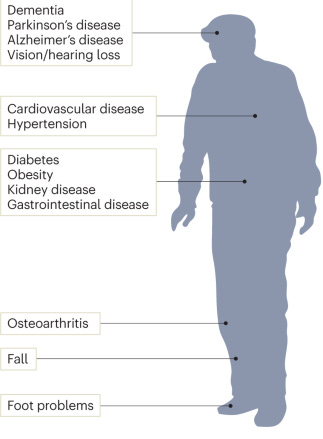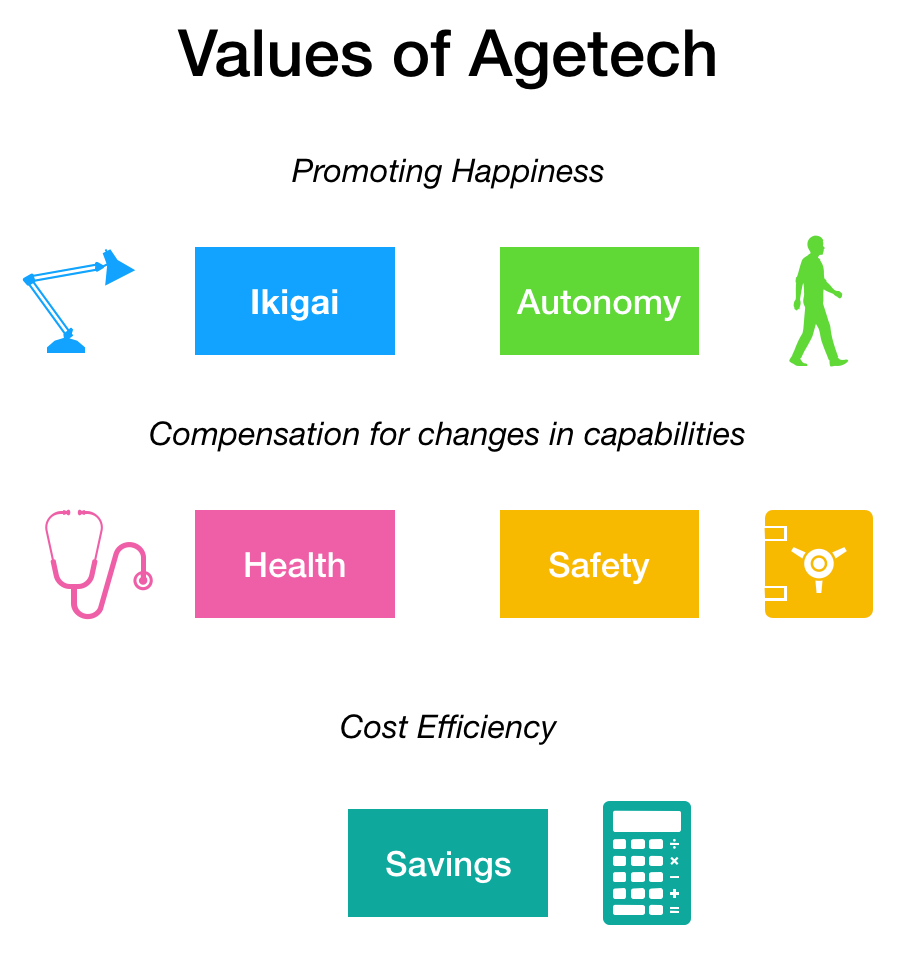#2 What is AgeTech?
How do we define AgeTech as a category of innovation, company formation and investment? Here I propose a framing based on the different value props that AgeTech can have.
As I do more research on agetech, it becomes apparent to me that the category lacks a satisfactory definition.
For this reason, I thought it would be worth putting pen to paper to describe how I conceptualize the category based on my learnings from the research community today.
I have experience as a climate tech investor, and within climate tech significant effort has been made to define the different technologies and pathways to take society to net zero. Might we similarly think of agetech as technologies that are needed to help us realize a goal of healthy aging in society?
A lot of resources out there define agetech through the underlying technologies (IoT, wearables, robots, etc). I will not pursue that approach in this post as I think the problem here is that the goal of healthy aging in society is not well-defined. I think that technologies are a means to the end. In climate tech, the end is clear — to help society reduce GHG emissions and and adapt to climate change. Agetech does not have this clarity today. Here I will make an attempt to resolve that issue.
Target Market
So let’s start with the most obvious answer to the definition of agetech: isn’t agetech just technologies for “older populations”? Typically this is defined by an arbitrary threshold, usually 65+.
This definition obscures the remarkable variation between people within this cohort, based on on factors including:
Physical dexterity (e.g., mobility)
Sensory acuity (e.g., visual and auditory)
Cognitive capability
Comfort with technology
The reality is just because someone is a certain age certainly does not mean that they face the same age-related issues. Additionally, each individual’s profile changes over time. In some cases, the key may be technologies with evolutionary capabilities as opposed to technologies that are suitable for one theoretically proposed age group.
To add to the complexity, not all agetech start-ups sell to older populations directly. Other payers of agetech solutions are those that are tasked with the care and responsibility for older populations, which include professional caretakers, health care providers, family members, and govt. The target market for certain agetech solutions could also be entirely compose of younger populations who are interested in improving health and nutrition so that they can stay healthier as they grow older.
For this reason, I think agetech should not be defined as technologies for older populations, but instead technologies that address common aging-related needs for both individuals and their caregivers. Below I will define the different dimensions of age-related needs that agetech can target.
This framing can also help to reduce the stigma of agetech by re-framing “technologies for older people” to “technologies that address aging-related issues”. This acknowledges that aging-related issues like Alzheimer’s or mobility loss are just aspects of a person, not what defines them.
Value Prop of Agetech
When I look at a start-up, the fundamental question that I always ask myself is, what is the value prop that the companies offers? This is true regardless of the industry of the company in question.
So, every agetech solution must address a perceived age-related need. Here I propose five value props to help people deal with age-related issues. The proposed value props also address my view of what healthy aging in society looks like.
AgeTech Value #1: Ikigai (meaning of life): This is the first value prop listed as I think this is the dimension of agetech that is least discussed. Ikigai is a term that originates from Japanese, and it means the “reason to live”. All of us are driven by Ikigai, the for-the-sake-of-which that is key to a happy and healthy life. Post-retirement, older adults need to redefine where in society they fit and how they are connected with everyone else. Technologies can help to enable this and become the basis for new communities and relationships to form.
Communication and entertainment technologies can be parts of the puzzle. Another approach is to keep older adults active through work, whether this be through continued regular employment or through other lower intensity engagements like volunteering or consulting. Working at an old age may sound depressing to some, but may be necessary for ikigai to others. Additionally, countries like Japan, Germany, and Italy are considered “super-aged”, with over 25% of their population over 65. For these super-aged countries, engagement of older populations into the economy may be a necessity.
AgeTech Value #2: Autonomy: For older Americans living outside of a nursing home, 25% of those aged 65 to 74 and 50% of those aged 75 and older have reported some kind of disability, such as problems with vision, hearing, or mobility (link). Assistive technologies can mitigate the impacts of decline of physical ability so that individuals can continue on with previous activities despite the changes (e.g., hearing aid addresses hearing problems). Even without addressing specific physical limitations, there are many technologies that can make the lives of older people more convenient, whether this be delivery apps, ride shares, etc.
One way to think about independence and autonomy is the ability of individuals to conduct activities of daily living (ADLs) and instrumental activities of daily living (IADL) (link). These are defined as:
ADL: eating, bathing, dressing, toileting, transferring, walking, and managing continence
IADL: cooking, driving, using the telephone or computer, shopping, keeping track of finances, managing medication, doing laundry, and housekeeping
The first post on agetech ventures on personal mobility (link) tackles just one aspect of these activities but clearly there is much more to it to cover in the future!
AgeTech Value #3: Improved Health Outcomes: The diagram below provides a great overview of representative health problems faced by older populations. Technologies can help to mitigate the impacts of these conditions as they occur.

Unfortunately, many older adults have multiple chronic conditions, which means increasing complexity of care needed, often from multiple providers and multiple care settings. These older adults are also more likely to experience poly pharmacy (taking between 2-7 medications daily), which increases the risks of medication errors and adverse events.
Given the wide-ranging consequences of age-related health impacts, there is significant interest in preventative health measures that can delay the onset of conditions and add time to lifespans. This pertains to different aspects of health, including nutrition, hygiene, and physical exercise. This is also relevant for younger consumers who do not fit into the “older population” bucket, but are interested in longevity.
One challenge here is that agetech healthcare innovations are challenging to test in clinical trial settings. Aging related health conditions have many concurrent complexity that can be difficult to control for in an artificial lab setting.
AgeTech Value #4: Safety: Older populations are more susceptible to fraud and exploitation as they experience cognitive changes. Scams targeting individuals aged 60 and older caused over $3.4B in losses in 2023 in the US (link).
The consequences of fraud vicitimization are more severe for older adults than younger adults as older adults usually lose more money, are less likely to report the incidents, and lack the earning capacity to recuperate from the loss (link). Technologies can offer a piece of mind to both the individual and the individual’s relatives and caretakers.
AgeTech Value #5: Cost savings: Given we are in a capitalist society, cost efficiency is a viable value prop for every target market and agetech is no exception. The cost savings benefit not only the older individuals but also their caregivers.
There are at least 17.7 million individuals caring for someone aged 65 and older with an impairment in the US (link). Given that by 2035 there will be 78 million individuals older than 65 (outnumbering those under 18 for the first time), solutions are dearly needed to make caretaking more efficient (link).
For example, increasing adoption of telehealth and robotics has the potential to reduce the stress and demands on caregivers. However, many older adults may prefer the personal contact with people and will resist against this approach…
Tensions between conflicting value props
I would be remiss to not identify some critical tensions between the different value props that I listed above. Here are just a couple that come to mind that an innovator in the space will likely face.
Autonomy vs. Safety
There is a risk in allowing older populations to maintain independence while they may not be aware of the physical/cognitive declines that put them at risk from a safety perspective. For example, many older people prefer to continue driving but that may be at the detriment to their own and others safety.
Improved health outcomes vs. Autonomy
A lot of the technologies available to improve health outcomes are based on more extensive and potentially invasive monitoring technologies. How do we think about the trade-off between foregoing privacy for improved health> Additionally, as we age, we have more complex care needs from a health perspective that also make it harder for us to take care of ourselves.
Cost Savings vs. the rest
Older populations have limited financial resources as the majority live off of savings and fixed incomes, and hence are unlikely to invest in agetech unless there is a clear perceived need. Caretaking facilities are also profit-driven organizations that are not incentivized to invest in agetech unless there are clear outcomes and efficiency improvements.



